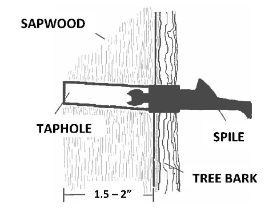By Bill Klase, Extension Natural Resource Educator
Now that spring has arrived, many of us are itching to get outside and tap some maple trees for sap. One of the critical parts of this process is getting the tap hole right. It’s easy to do it incorrectly, which can impact the quantity and quality of your sap. To make sure you get it right, check out the following tips to follow and live by.

Avoid old tap holes. Areas of your trees that have already been tapped will produce far less fresh sap and sometimes none at all. You will know if you hit an old tap hole if the shavings are dark in color.
Use maple tapping bits. Regular drill bits will work but not nearly as well as tapping bits. Tapping bits are designed to remove the shavings from the drilled hole, while regular drill bits may require moving the bit in and out of the hole a few times to get all the shavings out.
Keep your bits clean. Minimize the chance of contaminating your tap holes by keeping your bits clean. You don’t have to wash them between drilling holes or trees, just try not to place them on the ground or place them on unclean surfaces. Excess microbial growth will slow the flow of sap and potentially spoil it.
Make the holes as round as possible. Oval-shaped holes won’t seal correctly around your spiles, which can lead to leakage. This is especially important for vacuum systems.
Use just one in-and-out motion. The more times you drill into a hole, the less likely the hole will stay round. A steady stance with good footing is the key to round holes created in one motion.
Angle the tap hole slightly upward. This will facilitate sap flow out of the tree.
Make the tap hole no more than 2 inches deep. Most of the sap transport is taking place in the newest wood within about 2 inches or so from the surface. Deeper wood will not transport as much sap and usually has a lower sugar content.
Clean out debris and shavings from the tap hole. You can do everything right and still get some shavings or debris in the tap hole. These may inhibit the flow of sap or stop it all together. Use a clean nail or wire to clean out the debris. Don’t “blow it clean.”
And that’s it! Don’t be in a hurry and do it right; you should get a good supply of sap from each tap. Remember, no more than two taps per tree and only one if the tree is less than 2 feet across. May you have a fun and productive syruping season!




